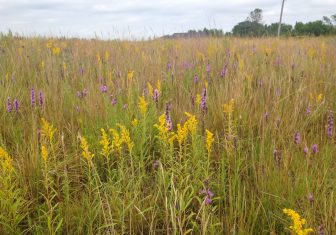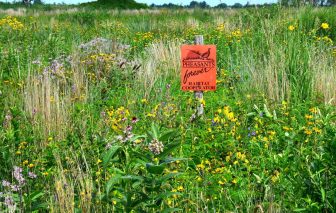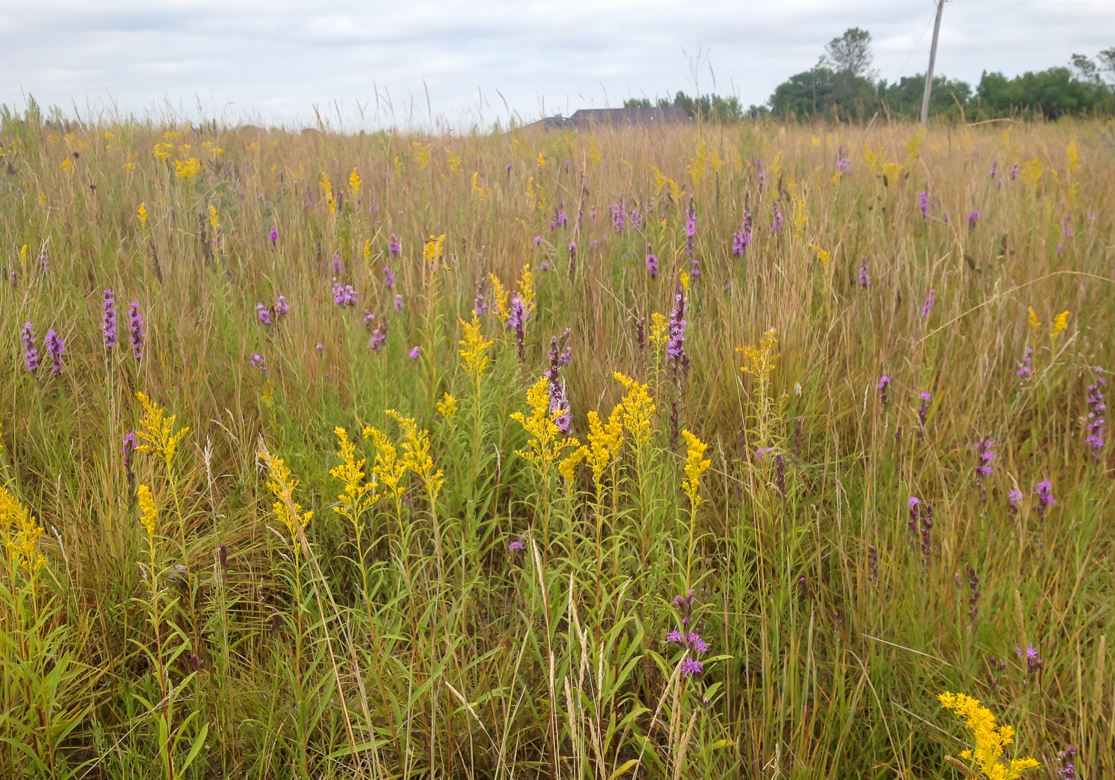
Prairies with many wildflowers are good habitat for pollinators and other wildlife species. Credit: Ruth Thornton
By Ruth Thornton
Gary Groff fondly remembers hunting all day on his grandfather’s land as a boy. “For my dad’s life he could not believe that I could go out there before daylight and come back after dark,” he said.
Now retired for many years, he still hunts the central Michigan property with friends.
The parcel is partially wooded and partially farmed, but the farmland is poor. “The soil is sandier than heck,” Groff said, and the farmer who rented it did not make much money from the crops.
So, a few years ago, they enrolled the parcel in a government set-aside program and seeded it with native grasses and wildflowers. Now, the farmer “gets paid more for leaving it idle than he does for farming,” Groff said.
The program is one of many by state and federal agencies to restore grasslands and native prairies in Michigan. Some target poor farmland prone to erosion to take it out of production, while others help private landowners manage their land for recreation or conservation.
Many grasslands and wetlands created through these programs provide valuable habitat for pollinators and other wildlife.
While Michigan is not known for its expansive areas of prairies like states farther west, they did occur here, said Tyler Bassett, a botanist with the Michigan Natural Features Inventory.
“They were more like islands within the forest and savanna landscape,” Bassett said.
Some of those islands were surprisingly sizable. “The largest mapped individual prairie was 12,000 acres,” he said. That’s about half the size of Walt Disney World.
“Fast-forward to now, I would say there’s no historically remnant prairie in Michigan,” Bassett said, but only small patches left mainly in railroad rights-of-way and cemeteries.
That is problematic for many animals that depend on them, such as grassland birds and pollinators.
“That’s probably one of the most ecologically important reasons to be planting prairies, because these are guilds of species that are disappearing at catastrophic rates,” Bassett said.
Losing those species is like pulling the threads from a sweater, he said. Each individual species lost may not have a big impact, but if too many threads are pulled, the sweater will no longer hold together.
“We as humans depend upon the integrity of ecosystems to support an environment that we can live in,” he said. “That provides clean water and clean air and productive soils and all the things that we’re kind of seeing unravel right now before our eyes.”

Grasslands provide much-needed habitat for pheasants and other birds. Credit: Michigan DNR, courtesy of Pete Berthelsen, Pheasants Forever
Even small native flower plantings can have big benefits. “You can create insane amounts of pollinator habitat pretty easily,” Bassett said.
Meredith Holm, Great Lakes pollinator coordinator for the U.S. Fish and Wildlife Service, says even small native flower plantings can have a big impact.
“There’s some that are as small as a tenth of an acre or less,” she said of the pollinator habitat projects she works on in metro Detroit. “But then you do another tenth of an acre, or half an acre, and so it’s really started to be a network of pollinator habitats out there.”
She says that anybody can participate in the program and make a difference by putting in habitats for pollinators and wildlife. Even renters.
“If you have a balcony, or you have anything where you have sun,” she said, “you can put flowers and boxes” there.
Michigan’s funding for private lands conservation has decreased in recent years, but the state is still working with landowners on habitat projects, said Kenneth Kesson, a wildlife biologist with the Department of Natural Resources.
“There’s lots of historic wetlands, pocket wetlands and things like that, that can be restored,” said Kesson, who works with the state’s Private Lands Program. “Often we’ll complement a wetland restoration with a prairie buffer planting to benefit waterfowl and other species.”
Those prairie plantings help pollinators, but the benefits reach beyond those beneficial insects, said Jim Hazelman, a wildlife biologist with the U.S. Fish and Wildlife Service who coordinates the Partners for Fish and Wildlife program in Michigan.
“When we design a pollinator habitat or a wetland, you’re going to benefit deer, turkey, the huntable species, as well as the non-game species,” Hazelman said.
“A lot of deer hunters will plant all this specialty stuff — clovers, beets, all these other things that they’ll pay money and put food plots in,” he said. “Well, that pollinator planting is one giant food plot.”
Hunters notice that.
“I’ll plant that wildflower patch, and then they’ll come back several years later and say ‘my deer are all in that pollinator planting,’” Hazelman said.
Then the word often spreads and neighbors who at first were reluctant to try something new are interested in working with the Fish and Wildlife Service.
Hazelman said the program he works on has changed in recent years from partnering primarily with landowners who hunt to people who want to restore habitats for conservation.
“So we’re reaching additional people,” Hazelman said. “And I think the pollinator habitat and the native grassland habitats really facilitate that change.”
With so many different government agencies offering habitat restoration programs, it is easy to get confused which ones to apply for.
Kesson encourages people to reach out to either the Michigan DNR or their local conservation district if they have questions.
“We’re a fairly tight knit community,” Kesson said. “We know each other, we generally know each other’s programs.” If someone contacts him and his program isn’t right for their land, he will help guide the landowner to a program that can help reach their goals.
The Groff property may not be valuable farmland, but it is now providing habitat not only for pollinators but also other local wildlife.
Groff said he had gotten offers to sell the land to build houses, but he doesn’t want to do that.
“It’s the only place I got to hunt,” he said. “I got three or four friends that hunt out there. I just hate to see it go.”
